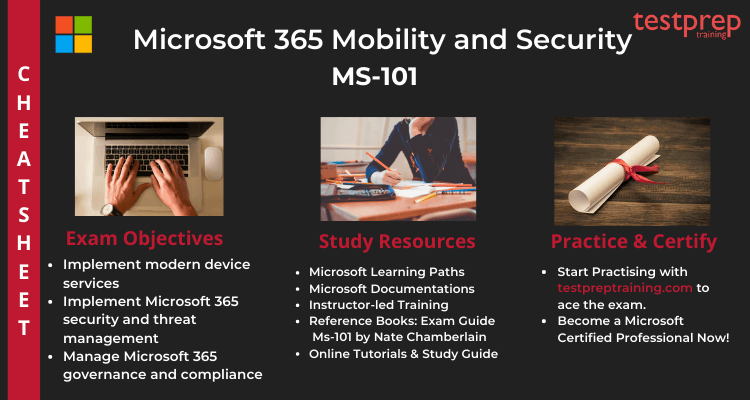Microsoft 365 Mobility and Security MS-101 accreditation add nothing but value to your profile. Earning an MS-101 certification, on the other hand, is no easy task. To put it another way, candidates will find it challenging to study for the certification exam on their own. You could be perplexed by some challenging information. However, you are in luck since our professionals have successfully produced and curated an MS-900 Cheat Sheet, which includes all of the necessary resources to pass the test. So, without further ado, let’s get down to business with the test specifics.
Microsoft MS-101 : Overview
Enterprise Administrators who participate in analyzing, planning, migrating, installing, and administering Microsoft 365 services should take the MS-101: Microsoft 365 Mobility and Security exam. These enterprise administrators are in charge of managing a company’s Microsoft 365 tenancy, including its identities, security, compliance, and supporting technologies.
Who should take the exam?
- Firstly, candidates need to be familiar with Microsoft 365 workloads and should have served as an administrator for at least one of them (Exchange, SharePoint, Skype for Business, or Windows as a Service).
- Secondly, candidates should also have a grasp of networking, server administration, and fundamental IT concepts like DNS, Active Directory, and PowerShell.
Cheat Sheet | Microsoft MS-101 Exam
To cover every element of revising for a certification test in a single article would be impossible. When it comes to certification test preparation, however, there are several important truisms and critical learning materials that every applicant should be aware of. This Cheat Sheet is the perfect tool for acing the test and passing with flying colours.

1. Start with the Exam Objectives
Before you begin your revisions, you should familiarise yourself with the exam’s primary goals. Knowing the exam objectives is critical for gaining an understanding of the exam. To have a better understanding of the test guide, go to the Microsoft MS-101 exam official website. A thorough analysis helps align yourself with the main goals of the exam, allowing you to attain the necessary skills for your desired certification. The exam covers the following domains:
The course outline for the Microsoft MS-101 exam was updated on November 2, 2022.
1. Plan and implement device services (35—40%)
1.1 Plan and implement device management by using Microsoft Endpoint Manager
- plan co-management between Endpoint Configuration Manager and Intune (Microsoft Documentation: co-management)
- plan and implement configuration profiles for Windows and MacOS clients (Microsoft Documentation: Create a device profile in Microsoft Intune)
- plan and implement configuration profiles for iOS and Android (Microsoft Documentation: Apply features and settings on your devices, Create a device profile in Microsoft Intune)
- review and respond to issues identified in Microsoft Endpoint Manager (Microsoft Documentation: Use Intune to remediate vulnerabilities)
1.2 Plan and implement device security and compliance by using Microsoft Endpoint Manager
- plan and implement device compliance (Microsoft Documentation: Use compliance policies to set rules)
- plan and implement for attack surface reduction (Microsoft Documentation: Configure attack surface reduction, Attack surface reduction)
- implement and manage security baselines (Microsoft Documentation: Use security baselines, Windows MDM security baseline)
- plan and configure conditional access policies for device compliance (Microsoft Documentation: Plan a Conditional Access deployment)
1.3 Deploy and manage applications by using Microsoft Endpoint Manager
- plan and implement application deployment (Microsoft Documentation: Create and deploy an application with Configuration Manager)
- publish public and private applications by using Microsoft Endpoint Manager (Microsoft Documentation: Getting started with Microsoft Endpoint Manager)
- plan and implement application protection policies (Microsoft Documentation: App protection policies overview)
- plan and implement application configuration policies
- monitor and troubleshoot application deployment (Microsoft Documentation: Deployment Monitoring Tool)
1.4 Plan for Windows client deployment and management
- choose Windows client deployment methods and tools based on requirements, including Windows Autopilot, USMT, Microsoft Deployment Toolkit, and Windows Deployment Services (Microsoft Documentation: Get started with MDT, Windows 10 deployment scenarios and tools)
- plan and implement Windows subscription-based activation (Microsoft Documentation: Windows 10/11 Subscription Activation)
- plan for Windows updates (Microsoft Documentation: Prepare servicing strategy for Windows client updates)
- plan and implement additional Windows client security features (Microsoft Documentation: Security baselines)
1.5 Plan and implement device enrollment
- plan and implement device join or hybrid join to Azure AD (Microsoft Documentation: Plan your hybrid Azure Active Directory join implementation)
- plan and implement device registration to Azure AD (Microsoft Documentation: Plan your Azure Active Directory device deployment)
- plan and implement manual and automated device enrollment into Intune (Microsoft Documentation: Set up enrollment for Windows devices)
2. Manage security and threats by using Microsoft 365 Defender (25— 30%)
2.1 Manage security reports and alerts by using the Microsoft 365 Defender portal
- review and respond to Microsoft 365 Secure Score (Microsoft Documentation: What is Microsoft Secure Score? Assess your security posture)
- review and respond to security alerts in Microsoft 365 Defender (Microsoft Documentation: Alerts in the Security & Compliance Center)
- review and respond to issues identified in security and compliance reports in Microsoft 365 Defender (Microsoft Documentation: Security dashboard in the Security & Compliance Center)
2.2 Plan, implement, and manage email and collaboration protection by using Microsoft Defender for Office 365
- plan and implement policies and rules in Microsoft Defender for Office 365 (Microsoft Documentation: Preset security policies in EOP and Microsoft Defender for Office 365)
- review and respond to issues identified in Microsoft Defender for Office 365, including threats, investigations, and campaigns (Microsoft Documentation: Investigate incidents in Microsoft 365 Defender, Review and manage remediation actions in Office 365)
- unblock users (Microsoft Documentation: Remove blocked users from the Restricted users portal in Microsoft 365)
2.3 Plan, implement, and manage endpoint protection by using Microsoft Defender for Endpoint
- plan Microsoft Defender for Endpoint (Microsoft Documentation: Microsoft Defender for Endpoint)
- onboard devices to Microsoft Defender for Endpoint (Microsoft Documentation: Onboard devices and configure Microsoft Defender for Endpoint capabilities)
- configure Microsoft Defender for Endpoint settings (Microsoft Documentation: Switch to Microsoft Defender for Endpoint – Phase 2)
- review and respond to endpoint vulnerabilities (Microsoft Documentation: Track and respond to emerging threats through threat analytics)
- review and respond to risks on devices (Microsoft Documentation: Review detected threats)
- review and respond to exposure score (Microsoft Documentation: Exposure score in Defender Vulnerability Management)
2.4 Plan, implement, and manage Microsoft Defender for Cloud Apps
- configure the application connector for Office 365 (Microsoft Documentation: set up a multifunction device or application)
- plan and configure Microsoft Defender for Cloud Apps policies (Microsoft Documentation: Get started with Microsoft Defender for Cloud Apps)
- review and respond to Microsoft Defender for Cloud Apps alerts (Microsoft Documentation: Manage alerts)
- review and respond to activity log (Microsoft Documentation: Azure Monitor activity log)
- configure Cloud App Discovery (Microsoft Documentation: Set up Cloud Discovery)
- review and respond to issues identified in Cloud App Discovery (Microsoft Documentation: new in Microsoft Defender for Cloud Apps)
3. Manage Microsoft 365 compliance (30—35%)
3.1 Plan and implement information governance
- plan and implement retention labels and label policies (Microsoft Documentation: Learn about retention policies and retention labels)
- recover deleted data in Exchange Online and SharePoint Online (Microsoft Documentation: Recover deleted messages in a user’s mailbox in Exchange Online)
- implement records management (Microsoft Documentation: Learn about records management)
3.2 Plan and implement information protection
- plan and implement data classification (Microsoft Documentation: Learn about data classification)
- plan and implement sensitivity labels and policies (Microsoft Documentation: Create and configure sensitivity labels and their policies)
- optimize label usage by using Content Explorer, Activity Explorer, and label reports (Microsoft Documentation: Get started with activity explorer)
3.3 Plan and implement data loss prevention (DLP)
- plan and implement DLP for workloads (Microsoft Documentation: Learn about data loss prevention)
- plan and implement Microsoft 365 Endpoint DLP (Microsoft Documentation: Get started with Endpoint data loss prevention)
- review and respond to DLP alerts, events, and reports (Microsoft Documentation: Configure and view alerts for data loss prevention polices)
3.4 Manage search and investigation
- configure auditing in Azure AD, including diagnostic settings(Microsoft Documentation: Integrate Azure AD logs with Azure Monitor logs)
- plan and configure audit retention policies for Microsoft 365 (Microsoft Documentation: Manage audit log retention policies)
- retrieve and interpret audit logs for workloads (Microsoft Documentation: Use audit logs to track and monitor events in Microsoft Intune)
- plan and configure eDiscovery and Advanced eDiscovery (Microsoft Documentation: Microsoft Purview eDiscovery solutions)
- specify a Content Search based on requirements (Microsoft Documentation: Create a content search)
2. Know your Study Resources
Passing the Microsoft MS-101 certification exam becomes difficult when the set of resources chosen is not apt. You should be very cautious when selecting materials since they will affect how well you pass the exam. Here are a few tools to help you keep on track with your planning.
Prepare for the Microsoft MS-101 exam using the Study Guide!
3. Microsoft Documentation
Microsoft offers Microsoft documentation that includes a variety of learning sections. You may simply learn Microsoft azure expert’s solution DevOps principles by using Microsoft documentation. Additionally, Microsoft documentation assists you in fully comprehending the various sizes of various Azure services. This will ensure that you are working around the clock while also learning a lot about Azure technology from industry professionals.
4. Learn with Books and Periodicals
Books are your oldest yet the most efficient medium to study from. They help you acquire knowledge in a clear and detailed manner. Furthermore, this helps you understand the basics of the exam topics. Also, you can find various books and periodicals in the market. So, we want you to which you can refer to the study for the exam. Following are the few Microsoft MS-101 course exam books which can support and guide your preparation process:
- Firstly, Microsoft 365 Mobility And Security – Exam Ref Ms-101
- Secondly, Microsoft 365 Mobility And Security – Exam Guide Ms-101 by Nate Chamberlain
5. Go for Instructor Led Training
Microsoft offers both online and instructor-led training options. These instructor-led training courses are essentially on-demand classroom sessions that you may schedule at your leisure, anywhere, and at any time. Additionally, these Microsoft MS-101 training sessions assist you in gaining an advantage on the MS-101 test. So, after you’ve found a Microsoft training partner, all you have to do now is go to their website and arrange training sessions.
6. Online Tutorials and Study Guide
Online Tutorials enhance your knowledge and provide in depth understanding about the exam concepts. Additionally, Microsoft MS-101 exam Study Guides serve as your companions on the journey to the exam. These resources provide support, keeping you consistent and determined, and enhance your revision process.
7. Practice Tests
Your last and final step of preparation is Self-evaluation. Also, self-evaluation helps you find out your core strengths and weak spots. Remember to start with practice tests once you finish your whole syllabus. Practice tests will allow the candidate to encounter the real exam environment around them. Therefore, they are important to boost your confidence. So, Start Microsoft MS-101 exam practice tests Now!



